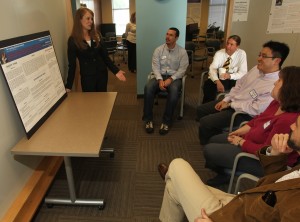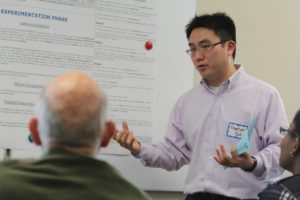Connecting teaching & researching: SoTL Symposium Re-Cap

Last week the CFT held a Scholarship of Teaching and Learning Symposium that offered a unique, interactive format aimed to give attendees practical knowledge and methods for developing, analyzing, applying, and sharing scholarship of teaching and learning (SoTL) work.
Brought together to connect, exchange ideas and strengthen the research community in teaching and learning at Vanderbilt, the attendees spent an hour engaged in ‘speed dating’-style roundtable discussions with seven presenters. They included:
- Cassandra S. Koontz
Missing the Forest for the Trees: Concept Map Horizontality and Performance in an Introduction to Biological Anthropology Course - Katie McEwen
Learning German on the Internet: How does a collaborative course wiki impact student learning in a fourth-semester German course? - Angela Cowser
Using Rubrics to Improve Student Comprehension and Writing - Kim Scott
A Comparative Analysis of Teaching Methods: Lecture Only, Demonstration and Hands-On Activities, and Written Instructions and Hands-On Activities - Wenyue Du
Impact of Online vs. Traditional Paper-and-pencil Homework Assignments in Student Learning in an Introductory Biology - Rebecca St. Clair
Students Prefer Standard Multiple Choice Questions - Menghun Goh
The Use of Semiotic in Teaching Koine Greek

While SoTL typically focuses on direct evidence of student learning, indirect or related information such as what students prefer or “like” is often collected in the process. Such self-reported evidence is meaningful, but considered with care.
Several of the projects featured data from student surveys, with questions about preferences for kinds of homework assignments, types of exam questions, and modes of classroom teaching. Two of the presenters offered interesting analyses based on what their students claim to “like”: one found that, although students strongly prefer one kind of exam question over another, the latter was actually in their best interests. Another found that her adult students liked and claimed to “learn more effectively” with one mode of teaching over another, even though their performances in the course showed no effect by the different teaching modes. Derek Bruff, who attended the event, was particularly encouraged by Wenyue Du’s finding that intro biology students preferred online homework to paper-and-pencil homework because the online homework allows students to keep trying to solve problems until they get the problems right.
Another important issue addressed in two SoTL projects dealt with language learning. Each tackled a fundamental challenge in the field: bridging the perceived gap between the rules of grammar and the act of translation. While each project addressed this issue in a different way, their common question connects with a problem faced across disciplines—namely, helping students see the relationship between learning the field’s content and and learning its process.

Leanna Fuller, senior Graduate Teaching Fellow at the event and consultant to many of the presenters throughout their participation in the the Teaching Certificate Program, noted that at this year’s symposium she was struck by how many of the projects sought to answer questions raised by everyday problems that so many instructors face in the classroom: Why do my students hate certain types of test questions so much? Why do students struggle with writing analytic papers, and what tools could I offer to help them? How might I use technology as a means to encourage students to practice collaborative learning?
“To me,” Leanna said, “what made these projects so compelling was not that they delivered hard and fast answers to these questions (in fact, that is not really the purpose of SoTL projects anyway). Instead, they were compelling because they were rooted in the day-to-day challenges of presenting a subject in ways that are focused on student learning.”
Although this year’s presenters may not have discovered definitive answers to their questions, the opportunity to create a SoTL project allowed them to start down the path toward finding those answers, and gave them tools that they will be able to carry with them as they explore new questions about teaching and learning in their future careers. Derek Bruff adds, “completing a SoTL project that results in strong conclusions is difficult, particularly for those engaged in SoTL for the first time. However, it was clear that our Symposium participants learned how to be more intentional about understanding student learning and the teaching practices that lead to it.”
All of the presenters are also participants in the CFT’s Teaching Certificate Program. As a part of the third cycle of the program, participants identify a line of inquiry that may be answered by collecting evidence of student learning during teaching opportunities available to the participants. This project is intended to help participants 1) develop deeper understandings of teaching and learning processes, 2) realize ways in which they can approach their teaching in a scholarly manner, 3) contribute to the larger community of teachers, and 4) prepare for future faculty roles in assessment and accreditation efforts. Through this event, the CFT hoped to inspire others with concrete examples of how to carry out a SoTL project.

Leave a Response